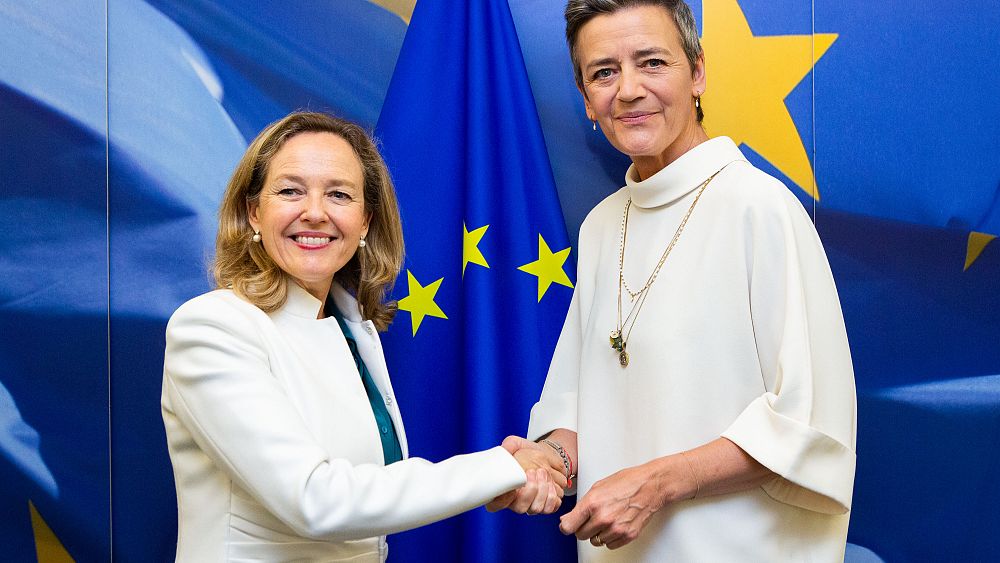World
EU aims for deal on fiscal rules in November as final deadline nears

The highly anticipated deal on the reform of the European Union’s fiscal rules will not arrive until November at the very least, pushing the bloc closer to its end-of-the-year deadline.
The appetite for postponement was evident during a meeting of economic and finance ministers in Luxembourg on Tuesday.
Upon arrival, representatives said the diverging views around the table were still too far from each other, dashing any hopes for a breakthrough.
Safeguards on debt reduction and exemptions for strategic investments are considered the main stumbling blocks, although talks are complex and replete with nuances.
Spain, the current holder of the Council of the EU’s presidency and moderator of the talks, has set its sights on the next ministering meeting, scheduled for 9 November, where the country intends to table a compromise text that could satisfy all sides.
“Issues are becoming clearer. We’re becoming more focused,” said Nadia Calviño, Spain’s acting minister for economy and digitalisation.
“We will continue working relentlessly between now and the end of the year in the spirit of consensus to reach a balanced agreement before the end of the year. Our ambitions are high but so are the stakes.”
Calviño noted that, while debt-reduction safeguards and investment incentives were the “crucial” points of friction, the different pieces of the puzzle needed to be understood as a whole and that “nothing is agreed until everything is agreed.”
The clock, however, is ticking. The bloc has self-imposed a deadline to wrap up the reform, which consists of three interlinked legislative files, before the end of the year.
The fiscal rules have been exceptionally suspended since the beginning of the COVID-19 pandemic and the European Commission intends to re-activate them on 1 January.
If the negotiations fail to conclude the reform, the rules will likely return to their previous version, which could entail painful sacrifices for highly indebted countries.
“We need to bring public finances back on track, preserve their sustainably and provide enough space for investment,” said Valdis Dombrovskis, the European Commission’s executive vice-president, who spoke next to Calviño after the ministerial meeting.
“In the meantime, fiscal policy needs to stay prudent, there’s little room for complacency with the current outlook,” he added, referring to bloc’s sluggish economic performance.
A complicated reform
The ongoing discussions are meant to overhaul the EU’s long-standing fiscal rules, officially known as the Stability and Growth Pact, and adapt them to the rapidly changing economic landscape of the 21st century.
Under the current framework, member states are required to keep their budget deficits under 3% of gross domestic product (GDP) and their public debt levels below 60% in relation to GDP — thresholds that many governments exceed after years of intense spending to cushion a succession of overlapping crises.
In the legislative proposal presented in late April, the European Commission kept untouched the 3% and 60% targets but made significant alterations to the way in which the two figures should be met.
Each member state would be asked to design a mid-term fiscal plan to cut down its deficit and debt levels at a sustainable and credible pace. The country-specific blueprints would be negotiated between the European Commission and the capitals, and later approved by the EU Council.
The fiscal adjustments necessary to meet – or at least head towards – the 3% and 60% targets would be carried out over a period of four years, extendable to seven in exchange for further reforms.
This renewed focus on national ownership and flexibility has been welcomed by indebted countries like France, Italy, Spain and Portugal, who face an arduous task to sanitise their finances and therefore advocate for greater room for manoeuvre.
“We should never forget these new (rules) are only a tool for a political goal. And the political goal is to have more productivity, more growth, more jobs for all European countries,” Bruno Le Maire, France’s economy minister, said on Tuesday.
But the push for greater flexibility has raised the suspicions of frugal-minded states, such as Germany, the Netherlands, Austria and Denmark, who fear governments would be granted excessive leeway to rein in their public finances.
This group is pushing to include numerical safeguards that would reinforce equal treatment for all member states, regardless of their starting point, and ensure an across-the-board reduction in debt and deficit levels every year.
“For us, (the) reduction of debt-to-GDP ratio and the annual deficits are connected. It’s not credible to seek lower debt levels without sustainable annual deficits,” said Christian Lindner, Germany’s finance minister.
Another divisive issue is an Italian demand to establish a so-called “golden rule,” which would exempt strategic investments in fields like the green transition, cutting-edge technology and defence from the deficit and debt computations.
This idea is frontally opposed by the German-led coalition because, they say, it could open the doors for too many concessions and weaken the credibility of the rules.
“We’re listening carefully to the discussion of member states and are open to discuss new possibilities,” said Dombrovskis. “But what we hear from these discussions, now, as it was also (the case) at the time the Commission put forward the proposal, there is nowhere near consensus on the so-called golden rule.”

World
13 killed as heavy rains unleash landslide in Haiti

At least 13 people died in northern Haiti following two days of heavy rains, officials said.
The majority of the deaths were caused by a landslide in the southeastern region of the coastal city of Cap-Haitien, according to a Thursday statement by Haiti’s Civil Protection Agency.
GANGS IN HAITI LAUNCH FRESH ATTACKS, DAYS AFTER A NEW PRIME MINISTER IS ANNOUNCED
More than 2,200 homes also were flooded, and there were significant losses in livestock swept away by the Haut-Cap river, authorities said.
Officials say at least 13 people died in northern Haiti following two days of heavy rains. (Photo by THONY BELIZAIRE/AFP via Getty Images)
Crews were clearing roads across northern Haiti, with additional rain expected in upcoming days.
Heavy rains also were reported in neighboring Puerto Rico, forcing at least a dozen flights scheduled to land in the capital of San Juan to reroute to the Dominican Republic and elsewhere, officials said Friday.
Widespread flooding also was reported in the U.S. territory.
World
‘It’s going to be worse’: Brazil braces for more pain amid record flooding

The death toll has climbed to 56 in Brazil’s southern Rio Grande do Sul state, with tens of thousands displaced.
Overpowering floods and mudslides caused by torrential rains are continuing to sweep southern Brazil, killing at least 56 people and forcing tens of thousands out of their homes, the government said.
As well as raising the death toll on Saturday, the country’s civil defence agency said rising water levels in the state of Rio Grande do Sul were straining dams and threatening the metropolis of Porto Alegre.
Triggered by storms that began on Monday, the flooding is only expected to get worse, local authorities said, as rescuers scoured the ruins of washed-out homes, bridges, and roads for missing people.
“Forget everything you’ve seen, it’s going to be much worse in the metropolitan region,” Governor Eduardo Leite said on Friday as the state’s streets were submerged.
‘Nothing could be saved’
The flooding, Brazil’s worst in 80 years, has so far affected at least 265 municipalities in Rio Grande do Sul, according to the southernmost state’s civil defence department.
It has injured at least 74 people, displaced more than 24,000, and left 350,000 with some form of property damage.
“Nothing could be saved,” said Claudio Almiro, who lost his home and possessions to the flooding.
“Many people have even lost their lives. I raise my hand to heaven and thank God that I’m alive.”
Residents in several cities and towns have been left completely cut off from the world, with no electricity or telephone access, while others have been forced to abandon their livestock.
“You don’t know if the water will continue to rise or what will happen to the animals, they may soon drown,” said Raul Metzel, from Capela de Santana, north of the state’s capital.
Five days in, as the rainfall shows no signs of letting up, four of the state’s dams are at risk of collapsing, creating the risk of a new “emergency situation”, according to civil defence officials.
Brazil’s federal government has sent aircraft, boats and more than 600 soldiers to help clear roads, distribute food, water and mattresses, and set up shelters, while local volunteers have also helped with search efforts.

‘Disastrous cocktail’
Climatologist Francisco Eliseu Aquino said the devastating storms were the result of a “disastrous cocktail” of global warming and the El Nino weather phenomenon.
South America’s largest country has recently experienced a string of extreme weather events, including a cyclone in September that killed at least 31 people.
Aquino said the region’s particular geography meant it was often confronted by the effects of tropical and polar air masses colliding – but these events have “intensified due to climate change”.
And when they coincide with El Nino, a periodic warming of the waters in the tropical Pacific, the atmosphere becomes more unstable, he said.
World
'Show solidarity': Pro-Palestinian protesters camp across Australian universities

-

 News1 week ago
News1 week agoLarry Webb’s deathbed confession solves 2000 cold case murder of Susan and Natasha Carter, 10, whose remains were found hours after he died
-

 News1 week ago
News1 week agoFirst cargo ship passes through new channel since Baltimore bridge collapse
-

 World1 week ago
World1 week agoHaiti Prime Minister Ariel Henry resigns, transitional council takes power
-

 World1 week ago
World1 week agoSpanish PM Pedro Sanchez suspends public duties to 'reflect'
-

 World1 week ago
World1 week agoUS secretly sent long-range ATACMS weapons to Ukraine
-

 News1 week ago
News1 week agoAmerican Airlines passenger alleges discrimination over use of first-class restroom
-

 Movie Reviews1 week ago
Movie Reviews1 week agoHumane (2024) – Movie Review
-

 Education1 week ago
Education1 week agoVideo: Johnson Condemns Pro-Palestinian Protests at Columbia University









/cdn.vox-cdn.com/uploads/chorus_asset/file/25433163/Screenshot_2024_05_04_at_9.55.04_AM.png)







